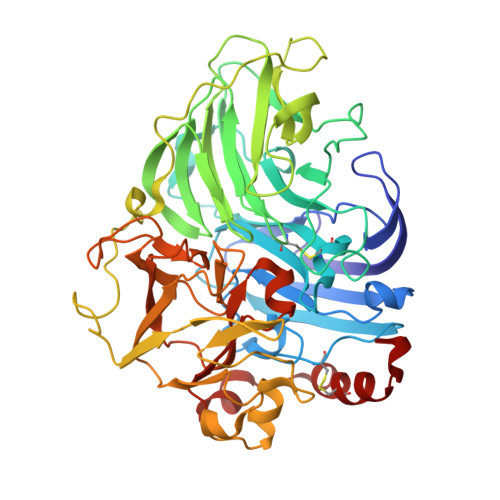Structural Changes Caused by Radiation-Induced Reduction and Radiolysis: The Effect of X-Ray Absorbed Dose in a Fungal Multicopper Oxidase
De La Mora, E., Lovett, J.E., Blanford, C.F., Garman, E.F., Valderrama, B., Rudino-Pinera, E.(2012) Acta Crystallogr D Biol Crystallogr 68: 564
- PubMed: 22525754
- DOI: https://doi.org/10.1107/S0907444912005343
- Primary Citation of Related Structures:
4A2D, 4A2E, 4A2F, 4A2G, 4A2H - PubMed Abstract:
X-ray radiation induces two main effects at metal centres contained in protein crystals: radiation-induced reduction and radiolysis and a resulting decrease in metal occupancy. In blue multicopper oxidases (BMCOs), the geometry of the active centres and the metal-to-ligand distances change depending on the oxidation states of the Cu atoms, suggesting that these alterations are catalytically relevant to the binding, activation and reduction of O(2). In this work, the X-ray-determined three-dimensional structure of laccase from the basidiomycete Coriolopsis gallica (Cg L), a high catalytic potential BMCO, is described. By combining spectroscopic techniques (UV-Vis, EPR and XAS) and X-ray crystallography, structural changes at and around the active copper centres were related to pH and absorbed X-ray dose (energy deposited per unit mass). Depletion of two of the four active Cu atoms as well as low occupancies of the remaining Cu atoms, together with different conformations of the metal centres, were observed at both acidic pH and high absorbed dose, correlating with more reduced states of the active coppers. These observations provide additional evidence to support the role of flexibility of copper sites during O(2) reduction. This study supports previous observations indicating that interpretations regarding redox state and metal coordination need to take radiation effects explicitly into account.
- Medicina Molecular y Bioprocesos, Instituto de Biotecnología, Universidad Nacional Autónoma de México, Avenida Universidad 2001, Cuernavaca, Morelos 62210, Mexico.
Organizational Affiliation:


















